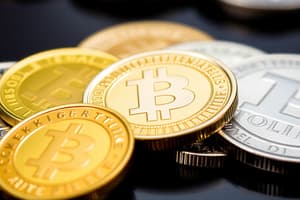Podcast
Questions and Answers
ما هي الخاصية التي تضمن أن تُقبل النقود في السوق دون أي مشاكل؟
ما هي الخاصية التي تضمن أن تُقبل النقود في السوق دون أي مشاكل؟
- سهولة النقل
- القبول العام (correct)
- صعوبة التلف
- تجانس الوحدات
أي من الصفات التالية تشير إلى ضرورة توحيد وحدة القياس للنقود؟
أي من الصفات التالية تشير إلى ضرورة توحيد وحدة القياس للنقود؟
- سهولة الحمل
- القبول العام
- تجانس الوحدات (correct)
- صعوبة التلف
ما هي الخاصية التي تعني أن النقود يجب أن تكون سهلة الحمل والنقل؟
ما هي الخاصية التي تعني أن النقود يجب أن تكون سهلة الحمل والنقل؟
- تجانس الوحدات
- صعوبة التلف
- سهولة النقل (correct)
- القبول العام
أي من الخصائص تتعلق بمواجهة النقود للتلف؟
أي من الخصائص تتعلق بمواجهة النقود للتلف؟
ما هو العنصر الذي يتطلب وجود وحدة نقدية واحدة في السوق؟
ما هو العنصر الذي يتطلب وجود وحدة نقدية واحدة في السوق؟
ما هي إحدى مزايا النقود الورقية؟
ما هي إحدى مزايا النقود الورقية؟
أي من الخيارات التالية يعد عيباً للنقود الورقية؟
أي من الخيارات التالية يعد عيباً للنقود الورقية؟
ما هو أحد الأسباب التي تجعل النقود الورقية مفضلة على العملات المعدنية؟
ما هو أحد الأسباب التي تجعل النقود الورقية مفضلة على العملات المعدنية؟
أي من هذه الجوانب لا يتعلق بمزايا النقود الورقية؟
أي من هذه الجوانب لا يتعلق بمزايا النقود الورقية؟
ما الذي تجنبه النقود الورقية مقارنة بالعملات المعدنية؟
ما الذي تجنبه النقود الورقية مقارنة بالعملات المعدنية؟
ما هو تعريف النظام النقدي؟
ما هو تعريف النظام النقدي؟
أي من الخيارات التالية لا يتعلق بالنظام النقدي؟
أي من الخيارات التالية لا يتعلق بالنظام النقدي؟
ما هو التعريف المناسب للنقود?
ما هو التعريف المناسب للنقود?
ما هي العناصر الرئيسية التي ينظمها النظام النقدي؟
ما هي العناصر الرئيسية التي ينظمها النظام النقدي؟
ما هي إحدى الوظائف الرئيسة للنقود?
ما هي إحدى الوظائف الرئيسة للنقود?
ما هو أحد أدوار النظام النقدي؟
ما هو أحد أدوار النظام النقدي؟
ما الذي تنظمه القوانين في النظام النقدي؟
ما الذي تنظمه القوانين في النظام النقدي؟
أي من الخيارات التالية يعتبر نوعًا من أنواع النقود?
أي من الخيارات التالية يعتبر نوعًا من أنواع النقود?
ما هي وظيفة النقود كوسيلة لتسوية المدفوعات?
ما هي وظيفة النقود كوسيلة لتسوية المدفوعات?
كيف تُستخدم النقود كاحتياطي للقروض في البنوك?
كيف تُستخدم النقود كاحتياطي للقروض في البنوك?
ما هو المكون الأساسي للنظام النقدي؟
ما هو المكون الأساسي للنظام النقدي؟
أي من الخيارات التالية يمثل واحدة من المؤسسات المسؤولة عن إصدار النقود؟
أي من الخيارات التالية يمثل واحدة من المؤسسات المسؤولة عن إصدار النقود؟
ما هو أحد الأبعاد المتعلقة بالنظام النقدي؟
ما هو أحد الأبعاد المتعلقة بالنظام النقدي؟
من أهداف النظام النقدي، أي من الخيارات التالية غير صحيح؟
من أهداف النظام النقدي، أي من الخيارات التالية غير صحيح؟
ما الذي يتم سحبه من التداول في سياق النظام النقدي؟
ما الذي يتم سحبه من التداول في سياق النظام النقدي؟
ما هو الاختلاف الرئيسي بين نظام السبائك ونظام المسكوكات؟
ما هو الاختلاف الرئيسي بين نظام السبائك ونظام المسكوكات؟
كيف تُظهر الدول قدرتها في نظام السبائك؟
كيف تُظهر الدول قدرتها في نظام السبائك؟
ما هي إحدى المزايا المتعلقة بأنظمة السبائك؟
ما هي إحدى المزايا المتعلقة بأنظمة السبائك؟
ما الذي يُعتبر عيبًا في نظام السبائك؟
ما الذي يُعتبر عيبًا في نظام السبائك؟
لماذا يمكن القول إن نظام السبائك أقل شيوعًا من نظام المسكوكات في العصور الحديثة؟
لماذا يمكن القول إن نظام السبائك أقل شيوعًا من نظام المسكوكات في العصور الحديثة؟
Flashcards
General Acceptance of Currency
General Acceptance of Currency
Currency must be widely accepted and used in transactions without hesitation or opposition
Uniformity of Currency Units
Uniformity of Currency Units
All currency units must have a standardized value for easy comparison and use in transactions
Durability and Portability
Durability and Portability
Currency needs to withstand wear and tear, and be easily carried and transported.
Definition of Money
Definition of Money
Signup and view all the flashcards
Functions of Money
Functions of Money
Signup and view all the flashcards
Types of Money
Types of Money
Signup and view all the flashcards
Stage 3 of currency
Stage 3 of currency
Signup and view all the flashcards
Paper money
Paper money
Signup and view all the flashcards
Paper money benefits
Paper money benefits
Signup and view all the flashcards
Paper money disadvantage 1
Paper money disadvantage 1
Signup and view all the flashcards
Components of a Monetary System
Components of a Monetary System
Signup and view all the flashcards
Monetary System Goals
Monetary System Goals
Signup and view all the flashcards
Monetary System
Monetary System
Signup and view all the flashcards
Currency Issuance
Currency Issuance
Signup and view all the flashcards
Currency Withdrawal
Currency Withdrawal
Signup and view all the flashcards
Unit of Account
Unit of Account
Signup and view all the flashcards
Monetary Regulation
Monetary Regulation
Signup and view all the flashcards
Currency
Currency
Signup and view all the flashcards
Difference between bullion and coinage systems
Difference between bullion and coinage systems
Signup and view all the flashcards
Bullion system gold control
Bullion system gold control
Signup and view all the flashcards
Bullion system handling
Bullion system handling
Signup and view all the flashcards
Study Notes
Monetary and Banking Issues
- Economic problems often stem from the scarcity of money.
- Barter is the exchange of one good for another.
- Challenges of Barter:
- Difficulty in finding mutual agreement between parties.
- Difficulty finding a common measurement for exchange rates.
- Difficulty in exchanging goods of significantly different sizes (divisibility).
- Difficulty in agreeing on future payments.
- Problems with perishable goods or large quantities, or with storage costs.
- Money emerged to address these issues, acting as a medium of exchange.
Characteristics of Money
- Universally accepted: It must be legally recognized.
- Uniformity: Units of the same type are equal in value.
- Durability: It should withstand wear and tear, and be easy to carry.
Functions of Money
- Medium of exchange: Facilitates the exchange of goods, separating the processes of buying and selling in time and space.
- Measure of value: Sets prices and exchange rates.
- Store of value: Maintains its purchasing power over time; if stable, it can store value.
- Medium of deferred payments: Allows for payments in the future.
- Reserve for Bank Loans: Banks use money as collateral.
Types of Money
- Commodity Money: Possesses intrinsic value (e.g., grain, livestock).
- Metallic Money:
- Earliest forms: Gold and silver, sometimes without direct relation to goods exchanged.
- Later forms: Gold and silver with a direct relation between the money and the goods traded; this was later established by some governments.
- Further later forms: Gold (or other single metal) as the only way representing value.
- Paper Money: Often unrelated to commodities, and its value comes from the issuing authority and public trust.
- Advantages: Reduced cost of production; prevention of wear and tear; lightweight.
- Disadvantages: Susceptible to counterfeiting, and potential inflation.
- Banknotes: A form of paper money issued by banks.
Monetary Systems
- Monetary system: Rules, regulations, and institutions associated with the creation and management of money.
- Components: Different forms of money circulating, institutions controlling money issuance and withdrawal, and related laws.
- Goals:
- Maintaining appropriate money supply for transactions.
- Ensuring flexible conversion between different types of money.
- Gaining trust in the country's money both locally and internationally.
Types of Monetary Standards
-
Commodity-backed money (metallic standards):
- Single-metal standard: Ties a unit of money to a specific metal (e.g., gold).
- Gold standard: One of the most prevalent systems where the value of currency is measured against gold, with a fixed exchange rate.
-
Fiat money (non-commodity-backed money): Unrelated to any commodity.
-
This type of money's worth is determined by law and public confidence in the issuing authority.
Specific Types of Monetary Systems
- Gold Coinage System: Currency's value linked to physical gold coins. Individuals could convert gold into coins or vice versa, with the state regulating the process. Individuals had freedom to produce gold coins and to trade such coins.
- Gold Bullion System: Individuals could exchange gold bullion (bars) for paper money or vice versa in certain situations and certain places. A key difference is that the state controlled gold reserves.
- Advantages and Disadvantages of Gold Coinage and Bullion systems (compared in the notes).
Studying That Suits You
Use AI to generate personalized quizzes and flashcards to suit your learning preferences.





